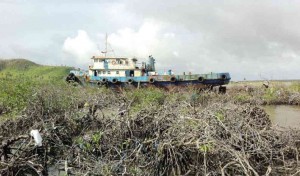
MANGROVES near a grounded boat in Quinapondan, Eastern Samar province, are showing signs of recovery from the effects of Supertyphoon “Yolanda.” PHOTO COURTESY OF JURGENNE PRIMAVERA
LOS BAÑOS, Philippines—The research arm of the Department of Environment and Natural Resources (DENR) said the damage left by Super Typhoon Yolanda to mangrove beach forests in Eastern Visayas was two to three times bigger than initial estimates.
According to the Ecosystems Research and Development Bureau (ERDB), mangroves in a 206-hectare plantation in the villages of Campoyong and Bungtod in Guian, Eastern Samar, failed to grow back its leaves six months after the typhoon struck in November last year, an indication that the trees had died even if their roots were still attached to the ground.
Such was also the case at mangrove sites in three other towns of Eastern Samar, namely, Lawaan-Balangiga (150 ha), Giporlos (400 ha) and Quinapondan (940 ha), said the ERDB report, a copy of which was furnished the Inquirer on Thursday.
In Tacloban City, Leyte, the mangrove seedlings now stood at 83 to 195 per hectare, a number far lower than that in a “recovering natural mangrove stand” in Palo, Leyte, with 475 seedlings per hectare.
This condition, according to the ERDB, was observed specifically among Rhizophora, a mangrove species that normally grows closer to land. Aside from defoliation, the roots had grown fungi, an indication of rotting.
“The actual damage is two to three times bigger than perceived immediately after Yolanda struck,” said ERDB Director Dr. Portia Lapitan in a phone interview Thursday.
Lapitan, who is also a Tree Physiology professor at the University of the Philippines Los Baños (UPLB), said the findings were based on a post-Yolanda mangrove assessment conducted from April 20 to May 3.
Two teams composed of 16 scientists and researchers conducted the study at six mangrove sites in Leyte and Samar. This was ERDB’s third assessment since last year.
Partial/minimal damage
In April, a group of scientists and civil society members released the results of an earlier four-month mangrove assessment in Leyte and Eastern Samar that found “partial/minimal to no damage at all” caused by the typhoon.
Early media reports quoted Dr. Jurgenne Primavera, a Pew Fellow in Marine Conservation and cochair of the International Union for Conservation of Nature Mangrove Specialist Group, as saying that only 100 to 200 hectares of mangroves in 13 towns and one city had suffered mortality.
“We wanted these (reports) clarified,” Lapitan said.
If the mangroves were to recover, they should have done so three months after the disaster, she added.
A P1-billion fund has been earmarked by the government for the rehabilitation of mangrove beach forests, the bulk of which would go to areas damaged by Yolanda. The amount is part of the P20 billion allotted by the national government for the reconstruction of areas hit by disasters last year, including those damaged by the earthquake in Bohol and the siege in Zamboanga.
The fund has yet to be released to the DENR.